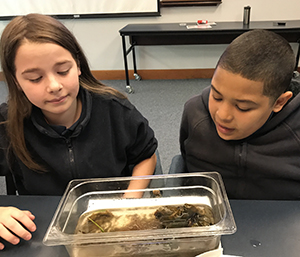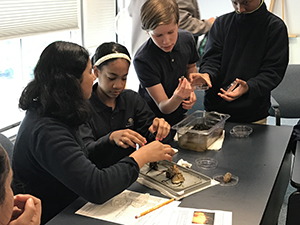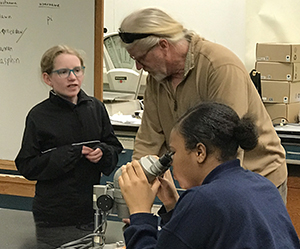By Edna Attias, 6th Grade Science Teacher

Sixth graders Corinne O’Hare and George Garcia identify invasive species.
The word invasive may sound harsh and intimidating, but not for marine resource specialist and middle school parent Kevin Cute. Mr. Cute is a marine scientist who works at the Coastal Resources Management Council (CRMC). The CRMC, a management agency with regulatory functions, works to preserve, protect, develop, and restore the state’s coastal areas by implementing specific management plans.

Qwin Cute (center) helps Jamie Flores, Daisha Jackson, and Jonah Diakite sort through and identify invasive species.
The CRMC uses three criteria for classifying organisms as invasive: they are harmful to the environment, to the economy, or to human health. Some of the marine invaders that have become established in Rhode Island include the European green crab, the Asian shore crab, red macroalgae, and various species of sea squirts and shellfish. Many of these organisms come from the ballast water used to balance and anchor ships so they will not capsize. Using ballast water involves taking water (with its entire content) from one port and disposing of it at another. This is how marine organisms from Japan, for example, can turn up in our waters. Another example is the bacteria that causes cholera in humans, vibrio cholerae, which has been discovered in very high numbers in the ballast water tanks of ships that have transited from foreign ports and docked in Chesapeake Bay. One of the policies that the CRMC helped promote is the treatment process that ballast water now has to undergo in order to kill organisms that may be transported with the water.

Aliyah Aileru peers at specimens through a microscope and verifies the organism as invasive. In the background, Kevin Cute and his daughter Zoe prepare other specimens for the class.
On a gloomy Friday morning in May, Mr. Cute cheerfully greeted the 6th graders of Paul Cuffee Middle School at the Graduate School of Oceanography at URI. Following a PowerPoint presentation about invasive species, students participated in a series of hands-on educational experiences, including an invasive aquatic species identification activity, examination and verification of the identified species under a microscope, and finally observation and interaction with various organisms that are native to the Narragansett Bay.
Students enthusiastically used the field guides provided to sort through buckets of organisms and made determinations about whether the species were invasive. Through this process, students were reminded to work like scientists and observe carefully before making any judgments. This day of learning outside our classroom was valuable as it exposed students to new content, enabled them to use scientific skills, and showed them the work of a true scientist in action.
Special thanks to Mr. Cute, who carefully and thoughtfully organized this trip for us; to Maryann Scholl from the Educational Partnership Department at URI, who enabled us to use the space at URI for no cost; and to Ed Baker, who is the manager for the seawater facilities. He allowed the students to come into his lab space and interact with exotic aquatic organisms like a rare blue lobster, a dogfish shark, skates, and others. Finally, I would like to thank Qwin and Zoe Cute, Mr. Cute’s daughters, who are students at the Paul Cuffee Middle School. They both served as research assistants for the day and helped with the execution of the field trip.


